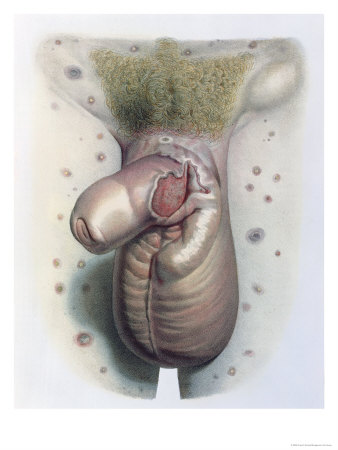 |
| Chancre |
This form, like the preceding one has no induration; if the edges or the base should appear swollen, such swelling is nothing else than a malignant oedema. The ulcers penetrate less to the subjacent tissues then they spread in circumference; they may preserve their round shape, but in most cases they spread about irregularly assuming a serpiginous character. Their base is generally uneven covered with a sort of whitish-gray false membrane or secreting a pulpy matter which, diffusing itself over the surface, shows here and there new granulations that, however, become decomposed again very speedily. The edges of these ulcers are generally very thin, irregularly indented, and, in places where they are gaping and detached, very frequently perforated by the ulcer. When first breaking out the ulcer begins with a scarcely perceptible swelling and slight excoriation of the surface. This excoriation soon becomes putrid, shows a yellowish base and secretes a watery, brownish ichor. Any tissue upon which this ulcer rises, may be destroyed by it; although the cellular tissue is more rapidly destroyed by it than the skin of the prepuce and the body of the penis. For this reason, when concealed under the integuments of the penis, the ulcer may spread onward towards the corpora spongiosa which it detaches from their covering, after which it continues to spread even as far as the pubes, so that it becomes impossible to completely lay bare the base of the ulcer. In such a case the visible portion of the ulcer is sometimes quite clean and even cicatrized, while the hidden portion is yellow and putrid, and secretes a copious quantity of a thin, brown ichor. This hidden portion is surrounded by the usual swelling, which can be felt externally like a hard ring surrounding the penis, and which, in proportion as the disease progresses, approximates more and more to the root of the penis. As long as this thick enlargement can be felt, so long does the hidden ulcer continue to progress; in proportion as the ulcer heals and cicatrizes from its base, the enlargement disappears with corresponding rapidity and certainty. Usually the progress of the ulcer is marked by putrid disorganization; accidental circumstances frequently convert it quite suddenly into a gangrenous sore (ulcus syphiliticum gangrenosum), causing the destruction and detachment of large patches of the prepuce, glans, or the corpora spongiosa. Very frequently a portion of the urethta becomes involved in the destruction. These phagedænic ulcers always secrete a copious ichor, which, however, does not seem to affect the parts with which it comes in contact, since the glans and prepuce are constantly seen inundated by this secretion without showing any signs of ulceration; or since the ulcer may be exclusively localized on the body of the penis, without the prepuce, which is in perpetual contact with the secreted ichor, being affected by it. The pain is seldom acute, and the inflammation not very violent. Nevertheless there are cases, especially if gangrene supervenes, where the inflammation may become intense, and the pain intolerable. On the other hand, the constitutional symptoms are often very prominent, the pulse accelerated, the skin hot, the appetite diminished, and the sleep uneasy and disturbed.